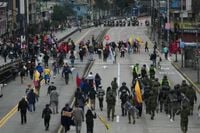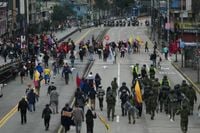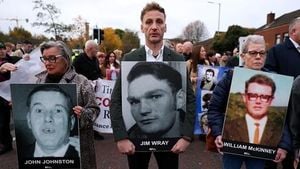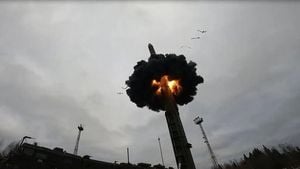In a dramatic turn of events that has gripped Ecuador for more than a month, the Confederation of Indigenous Nationalities of Ecuador (CONAIE) announced on October 22, 2025, the end of a nationwide strike that had brought parts of the country to a virtual standstill. The strike, which began in September, was sparked by President Daniel Noboa’s decision to eliminate a longstanding diesel subsidy—a move that sent fuel prices soaring from $1.80 to $2.80 per gallon and hit the country’s most vulnerable populations the hardest.
According to EFE, the strike’s conclusion followed a period of intense government crackdown, which left three people dead and many more injured. Two of the fatalities occurred in the Andean province of Imbabura, the epicenter of the protests, where demonstrators reportedly died from shots fired by security forces. In southern Ecuador, a 61-year-old woman from the Saraguro Indigenous group died from cardiorespiratory arrest, allegedly caused by tear gas. The human cost of the protests weighed heavily on the decision to end the strike. As Marlon Vargas, CONAIE’s president, stated in a video message, “In light of the government’s brutal repression, which resulted in three deaths and numerous injured people, we have made the difficult yet necessary decision to end the 2025 National Strike, clear the roads, and retreat to our territories to safeguard the lives of our people.”
The strike’s impact was felt far beyond the protest lines. The blockades halted traffic on key highways, disrupting commerce and daily life, especially in agricultural regions where diesel powers tractors, trucks, and buses essential for Ecuador’s poorest communities. The economic consequences were immediate and severe. As reported by the Associated Press, the Confederation of Indigenous Nationalities of Ecuador had called for the national strike after the government’s subsidy cut, which many saw as a blow to the livelihoods of rural and working-class Ecuadorians.
President Noboa, facing mounting pressure and paralyzed transport networks, announced that roads in Imbabura would be reopened “between today and tomorrow.” He credited dialogue with Indigenous communities for preventing the strike from spreading further across the country, though critics argued that the government’s approach relied more on force than on negotiation. General Henry Delgado of the joint chiefs echoed the government’s firm stance, telling reporters, “It can’t be that a number of Ecuadorians … want to impose themselves on 18 million Ecuadorians. We’re not going to allow that.” Troops were reportedly prepared to clear roadways in Imbabura, the province most affected by the blockades.
For many Indigenous leaders, however, the government’s use of force was a bitter pill. Marlon Vargas expressed “deep concern” over Noboa’s intervention in Imbabura and denounced the militarization of Indigenous territories. He demanded the immediate demilitarization of communal lands and the release of those detained during the demonstrations—including the so-called “12 of Otavalo,” who were prosecuted for terrorism after being arrested on September 22, 2025, following an attack on a police barracks in which ten vehicles were burned.
Vargas also called for justice for the families of the deceased and injured, insisting on reparations and medical treatment for those still suffering. He was adamant that there should be “no criminalization or persecution of the leaders and members of CONAIE.” In a pointed rebuke to President Noboa, Vargas said, “Mr. President, this strike could have been avoided if there had been dialogue and sensitivity before imposing decisions that affect the poorest. If the country had been administered responsibly, if the sick did not continue to die due to a lack of medicine, and if all sectors of Ecuador had been listened to, it could have been avoided.”
The end of the strike does not mean an end to resistance. Instead, CONAIE is shifting its focus to political mobilization. Vargas urged Indigenous groups to retreat to their territories and communities but to maintain “permanent assemblies and unity to prepare the campaign for ‘No’ in the popular consultation and referendum in defense of the Constitution, democracy, and acquired rights.” Scheduled for November 16, 2025, the referendum—initiated by President Noboa—will ask Ecuadorians to vote on the establishment of a Constituent Assembly to draft a new constitution and the possible return of foreign military bases to help combat crime, among other issues. The Indigenous movement has positioned itself firmly against these proposals, arguing that they threaten democracy and hard-won rights.
The government’s narrative has emphasized the need to restore order and protect the majority. General Delgado’s remarks underscored a belief that a vocal minority should not be allowed to disrupt the lives of millions. But for Indigenous leaders and their supporters, the events of the past month have highlighted a longstanding pattern: decisions made without meaningful consultation with those most affected. “Today, you have a lesson to learn: Power is not imposed; it is built through dialogue with the people,” Vargas asserted. “Today, more than ever, we reaffirm that the strength of the Indigenous movement lies in its unity and cohesion. They will not be able to divide or weaken us. We will continue together with one heart and one voice, defending Ecuador and our peoples.”
The strike’s aftermath leaves Ecuador at a crossroads. The government’s willingness to use military force to end civil unrest has raised concerns among human rights advocates, while the Indigenous movement’s resolve suggests that tensions are far from resolved. The economic and social wounds from the strike—compounded by the loss of life—will not heal quickly. As the country heads toward the November referendum, both sides are preparing for another showdown, this time at the ballot box.
For now, the roads in Imbabura and elsewhere are open, and the immediate threat of violence has receded. But the underlying issues—economic inequality, political exclusion, and the struggle for Indigenous rights—remain as urgent as ever. As Ecuadorians reflect on the events of the past month, many are left wondering what kind of dialogue, if any, can bridge the deep divides laid bare by the strike. The next chapter in Ecuador’s political story will be written not only by its leaders but by the millions whose voices have demanded to be heard.





